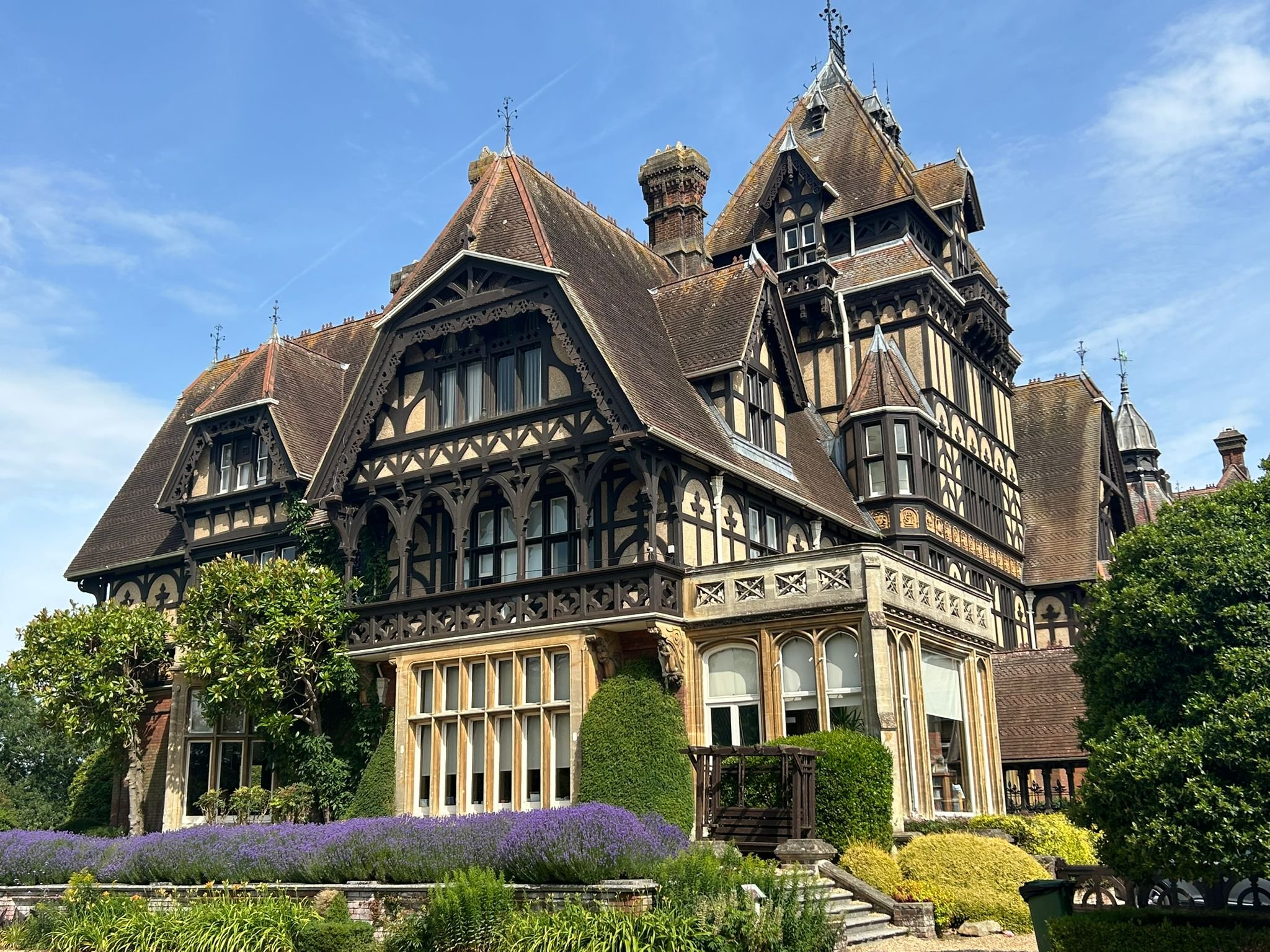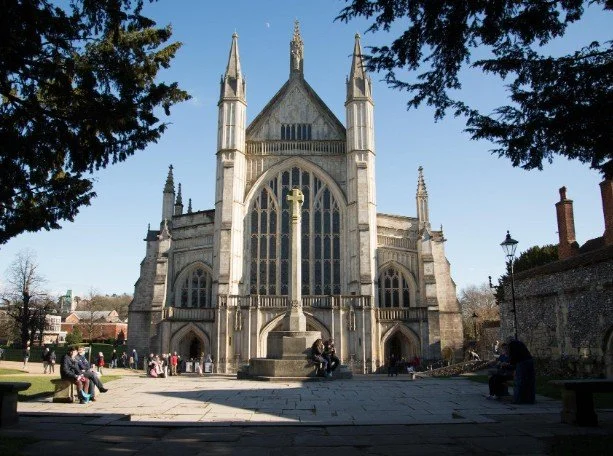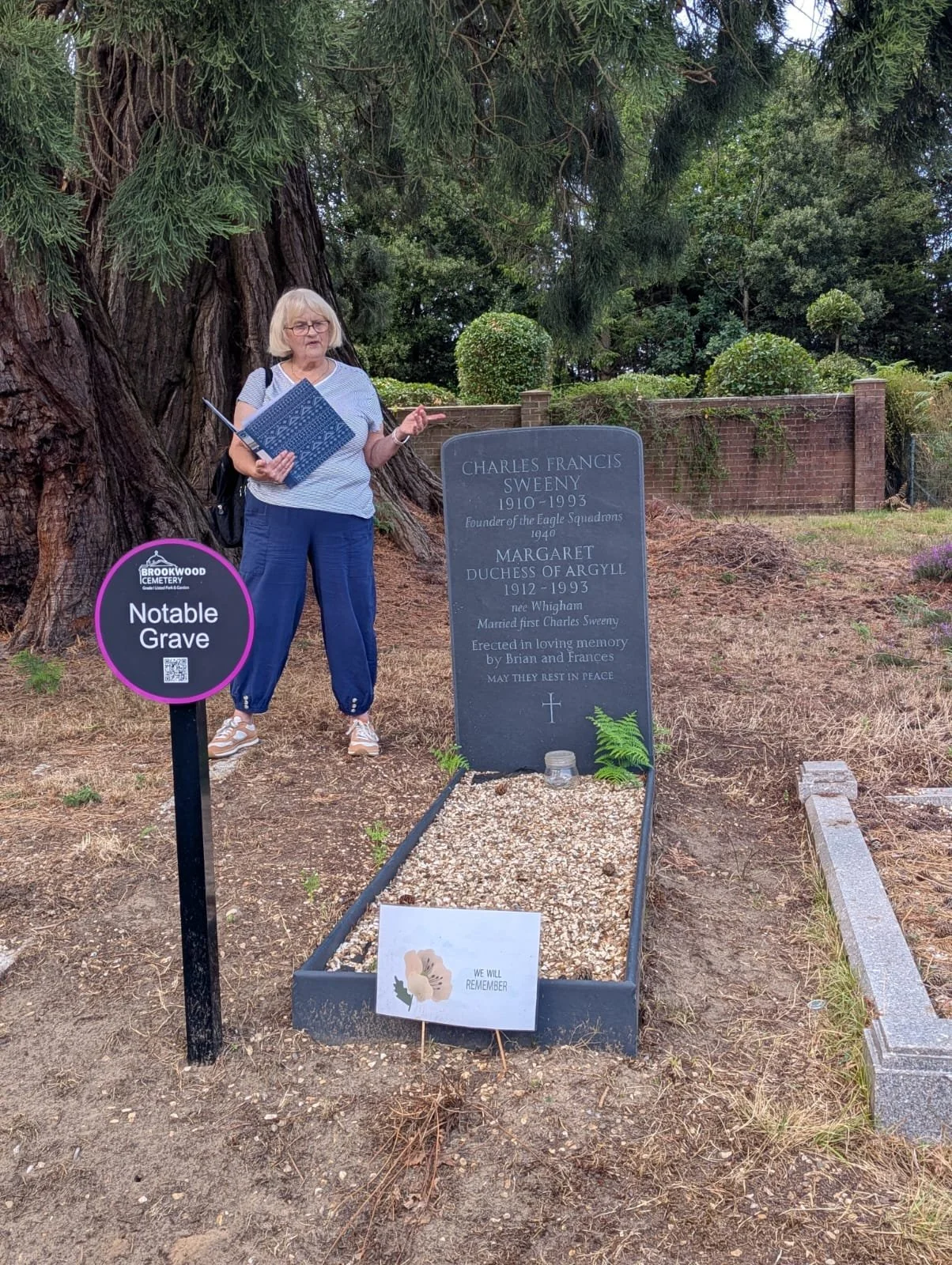Visit to Winchester Cathedral - October 2025
Our visit to Winchester Cathedral, on Friday 4th October, was arranged by members of the WI-Flyers’ Book Club, who were delighted to welcome ladies from the Craft Group of our neighbouring Farnborough WI, the Tilly Widgets.
It was a grim, grey day but we were determined not to let the wet and windy weather get the better of us. Having read the book A Single Thread by Tracey Chevalier earlier in the year, this was a visit we had been looking forward to with much anticipation.
An early start from Farnborough and a quick train journey down to Winchester afforded us ample time for a delicious brunch before we made for the cathedral.
We crossed the cathedral grounds, which were lovely even in the wind and rain, and headed towards this impressive building. As with all cathedrals, its size was imposing: Winchester Cathedral is the 6th largest cathedral in the UK and, at 170m, the longest medieval cathedral in the world. It was built between 1079 and 1532, so comprises several building styles from Norman, through Early English, to Perpendicular Gothic.
We met our volunteer guide, Peta at the main entrance, below the towering stained-glass windows that make up the west façade. Once inside, the atmosphere of peace and tranquillity dominated, even though there were many visitors about.
We were booked on the bespoke Stitched and Woven tour – of course we were, we had read the book and wanted to see for ourselves the beautifully embroidered cushions and kneelers created by the embroidery artist and textile historian, Miss Louisa Pesel, her friend the artist, Miss Sybil Blunt and 200 volunteer broderers (that’s embroiderers to you and me) in the 1930s. The work of these needlewomen was truly impressive and a delight to see in the flesh. To our great excitement, we were even permitted to pick up and handle these impressive works of art. The cathedral also houses earlier masterpieces of needlework, some dating from the marriage of Queen Mary to Philip of Spain in 1554, others from the late 19th Century and also modern works of created as recently as the Covid pandemic in 2020.
We were also delighted to see many of the locations and objects mentioned in the book, from graffiti to tombs and architectural features. Among them, the Fisherman’s Chapel, Bishop Gardiner’s Chantry Chapel, and St Swithun’s Shrine. As book lovers, we were thrilled to also see Jane Austen’s final resting place – she is buried beneath a ledger stone in the north nave aisle – and the memorial plaque installed by her family.
Our visit ended with much needed refreshments in the Refectory Café in the Cathedral grounds. Despite the miserable weather, we had had a lovely day out and we would certainly recommend a visit to Winchester Cathedral. General tours of the Cathedral take place every 20 mins, subject to the availability of guides, and last about an hour. The cost of a tour is included with a general admission ticket and guides are available to answer any questions you may have about the building, its history and its purpose.
Visit to Sandhurst - August 2025
It was time for another day out. On Wednesday 6th August 2025, we donned our posh frocks – and sun hats – and headed over to the Royal Military Academy Sandhurst to enjoy a few hours of pomp and circumstance. After identities were checked and we had all successfully got through the security controls, we entered the hallowed grounds of Sandhurst.
The Royal Military Academy Sandhurst is the home of the British Army Officer and since 1947, Officers serving in the British Army have undergone training here. Sandhurst has also trained over 5,600 International Cadets from countries all over the world, who have gone on to serve as Officers in their own armies.
RMAS covers a huge site. We have definitely all driven past it, but unless you have been inside you have no idea how big – and how beautiful – it is, even though it is located practically in the middle of Camberley.
We took our places in the stands in front of Old College – the oldest and most impressive building on the site – which was completed in 1812, just in time to train up some young Officers for the Battle of Waterloo in 1815!
Grateful for the shade provided by the stands, we watched the Commandant’s Parade for Regular Commissioning Course No. 243. The Commandant’s Parade is the last full dress rehearsal before the Sovereign’s Parade, which will be held on Friday 8th August 2025.
Led by the Academy Adjutant on his charger, Onyx and accompanied by the Band and Bugles of the Rifles, about 600 Officer Cadets marched on to Old College Parade Square. The Cadets looked very impressive in their Blues; boots, buttons and buckles shining, they stood to attention in the glaring sunshine while we enjoyed the shade.
We watched as the Sovereign’s Banner and the Colours (flags to you and me!) were marched on Parade. The Platoon deemed to have performed best in training, and so honoured with the title ‘The Sovereign’s Platoon’, then trooped the Colours through the ranks. Led by the Sovereign’s Platoon, the Cadets then marched past in slow and quick time. Prizes were awarded to the best cadets and the Commandant gave a motivating speech to those young men and women, who in the next few days would be leaving the Academy to take command of their own troops.
Finally, the parade came to an end as 242 of the cadets slowly marched up the steps and entered Old College to mark of the end of their training at Sandhurst. They were followed up the steps by the Academy Adjutant on his charger, one of the highlights of the parade.
It was an impressive occasion and a treat to witness it, a privilege normally reserved for the friends and families of those commissioning.
By now it was lunch time, so we left Old College and sauntered down to the lake where we spent the next hour or so enjoying a leisurely picnic before we finally headed home. Fed, tired, sunburned and to be honest a little bit impressed.
Visit to Newland’s Corner - April 2025
The Book Group had been reading, and thoroughly enjoyed, The Christie Affair by Nina de Gramont. We were so intrigued by what had happened when Agatha Christie went missing for 11 days in 1926 that we wanted to go and take a look at the place for ourselves.
Agatha Christie had disappeared on 4th December 1926, and her car was found teetering over the edge of a chalk cliff at Newland’s Corner, a beauty spot near Guildford. The car was empty, the lights had been left burning, and all that was found inside was her expired driving licence and a fur coat. It was a real-life mystery. We couldn’t restrain our curiosity and so on Sunday 5th April 2025 we put on walking shoes and headed off to Newland’s Corner.
In 1926 Newland’s Corner was a quiet, remote corner of the Surrey Hills. It is now a designated area of outstanding natural beauty, a 103-hectare nature reserve with wonderful, far-reaching views across the Weald to the Surrey Hills and beyond the South Downs. It is very popular for walks that take you along sandy tracks through woodland, heathland and open fields. Unlike in 1926 there is now a large car park, with a cafe, picnic tables and toilets for visitors.
After a good lunch at the - very busy - Plucky Pheasant (on the A25) we decided to follow one of the self-guided walking routes. It was a glorious sunny afternoon and our circuitous route took us back to our starting point. After a couple of hours of walking, we enjoyed a refreshing ice cream before we headed back to our cars and home … tired but thoroughly exhilarated by our excursion into this beautiful part of the country.
Visit to Brookwood Cemetery - July 2025
July 2025Brook
On Wednesday 23 July 2025, a large group of us took part in an evening guided tour of Brookwood Cemetery. This visit was in place of our usual monthly meeting at Cove Cricket Club. Most of us made our way to Brookwood by train as there is direct access to the cemetery from Brookwood railway station. In fact, the station would not exist if it were not for the cemetery.
In the 1800s London was expanding at an alarming rate and the city was finding it difficult to accommodate its growing population – of both the living and the dead. The London Necropolis Company‘s solution was to build a cemetery outside of the city and transport the deceased - and the mourners - there by train. And so, a dedicated branch line was built from The London Necropolis Railway Station next to Waterloo in central London. Land was bought in 1852 and work started immediately; in 1954 the first part of the cemetery was consecrated and the first burials took place. Initially, Anglican burials took place on the South side of the cemetery, and non-conformist burials on the North side, and two separate railway stations were actually built. Notably, the village of Brookwood did not start to be developed until the 1880s.
We all enjoyed our stroll along the walks and lanes, led by our knowledgeable tour guides, Alison and Eddie. Alison told us a great deal about the history of the site and also about various people buried there, some of them famous, some notorious. People of all faiths and nationalities are buried here – or cremated in the Glades of Remembrance. We visited several different areas and saw the Islamic, Turkish and Zoroastrian cemeteries. Many of the graves are beautiful, there are also impressive mausoleums, and several of the monuments in the cemetery have a Grade II listed status.
We were also able to visit the Brookwood Military Cemetery, where the Commonwealth War Graves Commission cares for the graves of over 5,000 service personnel from Australia, Canada, India, New Zealand, South Africa and the United Kingdom - all casualties of the First and Second World Wars. Brookwood Military cemetery was established 1917, and then extended after the Second World War. It is the largest CWGC cemetery in Britain and is, notably, the final resting place of twelve recipients of the Victoria Cross. The war graves of almost 800 casualties of other nationalities are also cared for here. Service personnel from Belgium, Czechoslovakia, France, Italy and Poland are buried here. Most notable of all is the area dedicated to the American Military Cemetery, a fittingly polished and pristine memorial to the fallen.
The atmosphere within the cemeteries is wonderfully calm and peaceful, something we all appreciated at the end of a long day. Some of us have even decided that it is a place we will return to, to explore further, yes. But also, to enjoy the tranquillity and to lose ourselves in the stillness.

The WI- Flyers Visit…..
The WI- Flyers Visit…..
The WI-Flyers visit Farnborough Hill - June 2025
Members of the WI-Flyers (Farnborough) paid a visit to Farnborough Hill on Saturday 21 June. We enjoyed a tour of this fabulous building and learned a great deal about its links with Farnborough Abbey and with the Royal Family.
The impressive house was built in 1860 by Thomas Longman, who founded the Longman publishing house. In 1880, the exiled Empress Eugénie, widow of Emperor Napoleon III of France, bought the house and lived here until her death in 1920. It was then bought by a religious order of nuns, who had already established a school for girls in Farnborough but needed bigger premises. It has been a school since 1927.
Farnborough Hill really is a hidden gem; it is situated in the middle of Farnborough but is well tucked away and rarely visited by those in the local community. We were able to see many of the beautiful rooms inside the house as well as the lovely gardens surrounding it.
At the end of our tour we were definitely in need of refreshment and were then treated to some superb tea and cake in the grand salon. We were hosted throughout by charming members of the teaching and administrative staff, Mrs Katy Bell, Miss Polly White and Ms Ailsa West, who were very attentive and looked after us superbly, answering all our questions and topping up our teacups.
It really was an excellent tour – and a very special morning.
Some photos of our visit



































